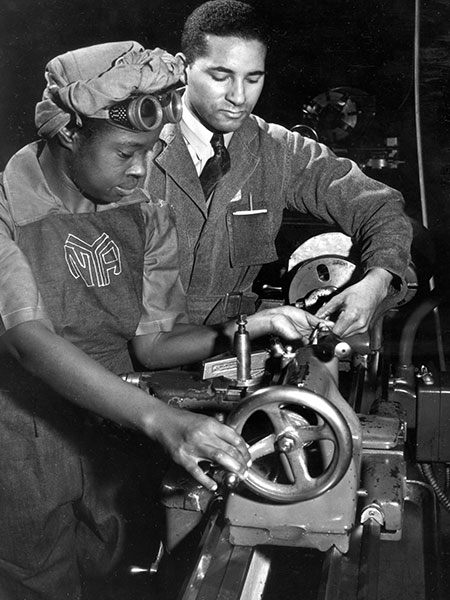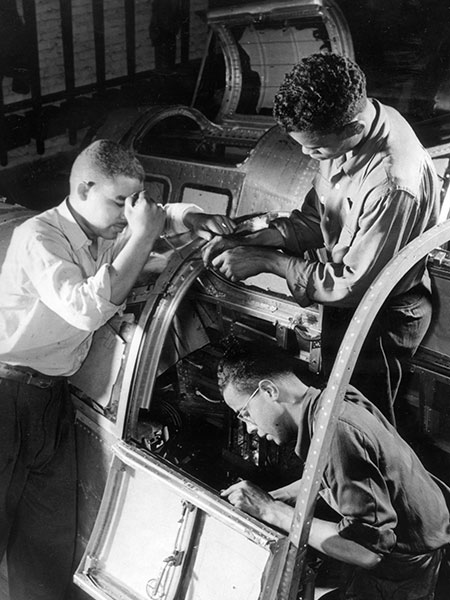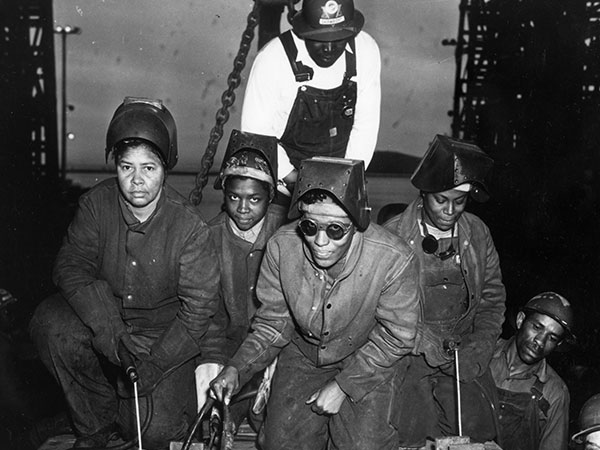During the War
The Home Front
-
With tens of thousands of former workers called up for service, Home Front employers sought a new work force—and black men and women traveled across the country in search of new opportunities and a steady wage. Wartime newsreels, photographs, and propaganda posters during this time depicted black and white men and women working together in harmony, but this was seldom the reality.
-
 Dr. Robert C. Weaver, Chief of the Minority Groups, Bureau of Placement, War Manpower Commission, worked to maximize black manpower in the defense industry. Library of Congress, LC-USW3-001658-C.
Dr. Robert C. Weaver, Chief of the Minority Groups, Bureau of Placement, War Manpower Commission, worked to maximize black manpower in the defense industry. Library of Congress, LC-USW3-001658-C. -
Executive Order 8802 had prohibited some discriminatory practices during hiring, but after hiring, companies were free to segregate. Cafeterias and restrooms were segregated. Black workers entered work through separate doors and lived in separate, often inferior housing. African Americans were frequently paid less, assigned more menial jobs, and denied the chance for advancement.
 Juanita E. Gray, a former domestic worker, learns to operate a lathe at the National Youth Administration training center in Washington, DC. National Archives, 208-NP-2QQQQ-1.
Juanita E. Gray, a former domestic worker, learns to operate a lathe at the National Youth Administration training center in Washington, DC. National Archives, 208-NP-2QQQQ-1. Juanita E. Gray, a former domestic worker, learns to operate a lathe at the National Youth Administration training center in Washington, DC. National Archives, 208-NP-2QQQQ-1.
Juanita E. Gray, a former domestic worker, learns to operate a lathe at the National Youth Administration training center in Washington, DC. National Archives, 208-NP-2QQQQ-1. African American workers assemble aircraft cockpits soon after completing a war industry training course. National Archives, 208-NP-2VV-2.
African American workers assemble aircraft cockpits soon after completing a war industry training course. National Archives, 208-NP-2VV-2. African American workers assemble aircraft cockpits soon after completing a war industry training course. National Archives, 208-NP-2VV-2.
African American workers assemble aircraft cockpits soon after completing a war industry training course. National Archives, 208-NP-2VV-2. -
In cases where a black worker did manage to get ahead, that success was met with protest or even violence by white workers. On June 3, 1943, 25,000 white workers at Packard Motors in Detroit walked off the job in protest to the promotion of three black workers.
 Welders Alivia Scott, Hattie Carpenter, and Flossie Burtos work on the Liberty ship SS George Washington Carver at Kaiser Shipyards in Richmond, California. National Archives, 208-NP-1HHH-5.
Welders Alivia Scott, Hattie Carpenter, and Flossie Burtos work on the Liberty ship SS George Washington Carver at Kaiser Shipyards in Richmond, California. National Archives, 208-NP-1HHH-5.




